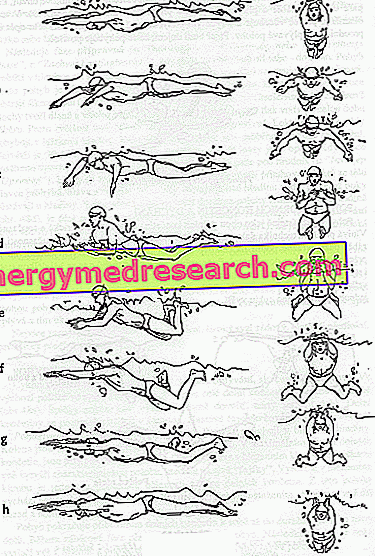The frog is an artistic style, the only one in which progress is obtained by successive pushes.
Compared to the other styles there is no push for the arms: the succession is therefore support, traction and recovery.
The position of the body is very inclined due to the frontal breathing, which is favored by the raising of the shoulders.
The main task is to push the legs, keeping the hammer foot.
Starting from the extended sliding position, the general coordination of the breaststroke swim begins with the movement of the arms.
Data sheet
Type of movement
Simultaneous and cyclical, both for upper and lower limbs
Body position
prone; it is determined in each cycle an alternation, of inclined and horizontal slide positions; the less hydrodynamic trim moments are due to:
- frontal breathing (reducing breaths, however, the attitude is not improved!)
- flexing of the thighs on the pelvis.
Upper limbs movement:
1) propulsive phase 2) carryover phase
1) Propulsive phase
Only traction is performed, which also includes the support / grip phase
The thrust is missing, which is present during the first cycle, after the departure dive and in the first cycle, after the turn. In the underwater frog the stroke also includes thrust.
The approach of hands and arms to the midline, as well as propulsion, facilitates a more hydrodynamic attitude
2) Reporting phase
The hands must remain well aligned.
The elbows come closer to avoid forming a braking "wedge" with the forearms (in this regard the supination of the hands can be performed).
The forward stretching of the arms can be made more penetrating by a slight "dip" forward.
Breathing
It is frontal and is favored by the raising of the shoulders, which avoids extending too far back to the head.
During the slide a moment of apnea must be respected, which determines a better buoyancy (the apnea time, of course, is related to the rhythm of the swim).
Lower limbs movement:
a flexion and a push are distinguished
1) Bending
The leg flexes as much as it can on the thigh; the thigh flexes on the pelvis with an angle (referred to the vertical) of about 45 degrees (130 between the thigh and the pelvis), which allows:
- keep your feet underwater at the right depth;
- do not push the thighs too far, slowing down the progress;
- develop a sufficiently horizontal trajectory;
- do not alter the coordination.
The feet are relaxed and in line with the legs; they absolutely must not be turned out.
The bending movement must be rapid, natural and relaxed
2) Push
It is an energetic movement of distension of the whole limb.
The feet, at the end of the flexion of the limbs, are flexed and rotated out.
The feet describe a trajectory with a flattened parabola and intervene from the beginning of the push until the complete stretching of the limb.
The useful surface in the push consists of:
- inner part of the sole of the foot;
- inner part of the ankle;
- inner part of the leg (only in the first half of the action).
Coordination
From the lying position:
a) it starts with the movement of the arms;
b) progressively the shoulders are raised;
c) the hands approach the midline and at the same time the lower limbs are called;
d) on the thrust of the latter the arms are stretched forward, while the head is aligned with the arms;
e) on the chute, more or less long, the cycle ends.

//jiri.patera.name/html/uk/entertain.html
Edited by: Lorenzo Boscariol



